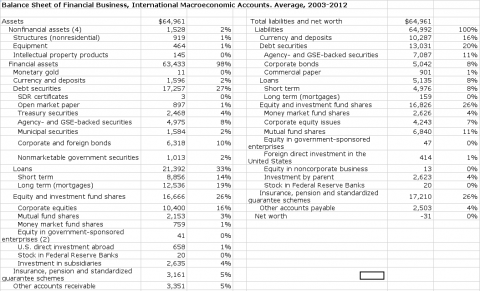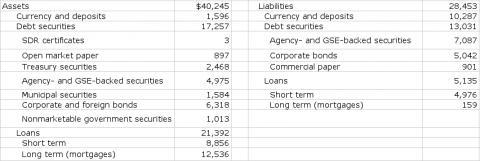Paul Krugman and assorted others have been puzzling at this question recently, one that I’ve been grinding an axe about for some years. For the first time, I think, Krugman’s highlighted the explanation that I keep going on about:
Inflation helps debtors and hurts creditors, deflation does the reverse. And the wealthy are much more likely than workers and the poor to be creditors, to have money in the bank and bonds in their portfolio rather than mortgages and credit-card balances outstanding.
Higher inflation means debtors pay off their loans in less-valuable dollars. So given an outstanding stock of trillions of dollars in fixed-interest loans/bonds, an extra point of inflation should transfer tens of or hundreds of billions of dollars a year in real buying power from creditors to debtors (without a single account transfer happening). Instantly and permanently.
I got some judicious pushback on this thinking in comments from JKH over at Interfluidity, where I had emphasized that rich households own the banks. (The top 20% actual own more like 85% of corporate equity.) While the 20% certainly have debts, they owe them mostly to themselves as bank shareholders, so The-20%-As-Debtors don’t benefit from the cheaper payback caused by inflation; it’s a wash. The 80% do get that benefit (and the 20% suffer), because the 80% owes money, on net, to the 20%.
I tried to simplify the situation with this:
Isolating one component that bank shareholders can be sure of, in a sea of complex and uncertain effects.
Imagine a bank (owned by shareholders, all in the top 20%) that owns a bunch of 30-year fixed-rate loans (borrowed by 80%ers) that won’t expire for 15 years. No ongoing lending by the bank. It just holds these loans and collects interest.
All interest is paid at the end of the year.
The banks’ interest revenues on those loans this year were $1 billion. Expenses were $100 million. $900 million in profit, all distributed as dividends.
Inflation over the next year (and ensuing) is 1%/year.
The bank again makes $900 million in profits, and distributes it to shareholders.
But the 80%er borrowers only pay $891 million in real buying power, and the 20%er shareholders only receive $891 million.
The next year, $882 million in buying power. Etc.
JKH pointed out out again that this only addresses inflation’s effect on the banks’ assets, not their liabilities. Very good point. Here’s an effort to address it, starting with the Balance Sheet account for Financial Business in the International Macroeconomic Accounts. (I averaged the balance sheets for 2003-2012 to get a big overall picture.) Click for larger image.
Now to ask: from the perspective of the 20%er shareholders/bank-owners, what effect will inflation have on these various assets and liabilities?
In many cases it’s quite uncertain (the whole point of the Interfluidity post linked above). They may presume that “Equities and investment fund shares” will go up along with inflation, for instance, so that’ll be a wash. What about “Insurance, pension, and standardized guaranteed schemes”? (I love “schemes” here.) Inflation should help them there, perhaps a lot, but how much and how will those schemes transform over future years and decades? Again, pretty uncertain.
But debt and debt securities are predictable, at least to the extent that they’re fixed-rate loans. Inflation hurts creditors. Period. Let’s just look at those assets and liabilities (click for larger):
Not all of these are fixed-rate, but we can assume that most of them are. (Estimates welcome.)
Here, banks’/20%ers’ assets (what others owe them) exceed their liabilities (what they owe others) by 12 trillion dollars. They’re net creditors. No duh.
To the extent that this stock of outstanding obligations is fixed-rate, an extra point of inflation will decrease 20%ers’ buying power by $120 billion a year.
Now you may suggest that that’s actually small change. It’s roughly 3% of the 20%ers annual income from capital,* and only $6,000 a year for each of the 20 million households in the top 20%. But you can be quite sure that that number is at least one order of magnitude larger for households in the top 1, .1, or .01%.
If the top 1,000 or 10,000 households (who dominate policy) perceive themselves as losing, say, $600,000 a year in real buying power for each point of inflation, are you curious why they hate inflation?
* Rough calculation of 20%ers’ capital income: (National income of $15 trillion – 60% of income going to labor) * Top 20’s 85% share of capital ownership = $5.1 trillion
Cross-posted at Angry Bear.


Comments
One response to “Why the Rich Hate Inflation: Because They’re Creditors?”
[…] Steve Roth — Why the Rich Hate Inflation: Because They’re Creditors? […]